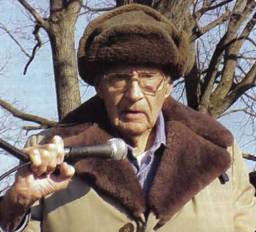![[Aerial Photo of Big Ear]](bigearhp.gif)
|
![[NAAPO Logo]](NAAPOsm.jpg)
|
|
Passage Dr. John D. Kraus June 28, 1910 - July 18, 2004 (W8JK, Silent Key) |
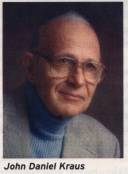
|
|
Newspaper & Magazine Articles
Table of Contents
(Below are internal links (bookmarks) to each article.)
From: The Delaware (Ohio) Gazette
OWU benefactor John Kraus dies
By TIM PICARD
Perhaps best known locally for the construction of the Big Ear radio telescope, Kraus was recognized worldwide for his research
in astronomy and physics.
His legacy may last longer for donating 80 acres of woodland and meadow, Kraus Nature Preserve, to Ohio Wesleyan University. Kraus and his late wife, Alice, moved to Home Road in 1960 and later purchased adjacent tracts. The land has a deep ravine, grassland and large trees and is restricted from development by deed. It is used by OWU and Ohio State University for biological study.
Recently interviewed by the Gazette, Kraus said the land and related study will be the couple's "eternal" gift to local scientists
and students. They're also responsible for three Kraus Fellowships that help students study the forest for both science and conservation.
OWU zoology professor Jed Burtt, who met Kraus in 1977, said the preserve is a "refuge that will last into perpetuity for students and researchers," adding that Kraus never dwelt in the past.
"He was always looking to the future," Burtt said. "We just spoke last week about the planning of a (global positioning system) grid
to map projects in the preserve."
The relationship Kraus established with local scientists also moved Burtt. "One of the things that was impressive about John was that he was an outstanding internationally known scientist who wanted to work with us," Burtt said.
Born in Michigan, in 1910, Kraus earned bachelor's, master's and doctoral degrees in physics from the University of Michigan, where he helped construct and operate the university's 100-ton cyclotron, at the time the world's most powerful particle accelerator.
During World War II, Kraus performed degaussing (protecting ships from magnetic mines) at the U.S. Naval Ordnance Laboratory and later developed antennas at Harvard University's Radio Research Laboratory.
In 1946, he joined the faculty of OSU, where he was professor emeritus of the electrical engineering and Astronomy departments.
tpicard@delgazette.com
JOHN DANIEL KRAUS
By Anna Michael
Thomas Edison was one of his heroes, but to many at Ohio State University and around the world, he was a hero himself.
John Daniel Kraus, a scientist and former professor at OSU, worked extensively with antennas and electromagnetics, making great strides in the electrical-engineering field during his life.
Kraus died Sunday at his home in Delaware. He was 94.
Kraus had touched the lives of many of the undergraduate and graduate students he taught.
According to John Volakis, professor and director of the ElectroScience Laboratory at OSU, Kraus was "a very careful teacher" who would come to class with experiments in his hands.
"He would excite people with how he would present things," Volakis said. "He was an icon and a man who drew awe from people."
Kraus also brought recognition to OSU for designing and building the "Big Ear" in 1965 near Perkins Observatory, south of Delaware. The huge radio telescope — as large as three foot-ball fields — recorded more than 20,000 deep-space radio sources, or quasars, by 1972. It was dismantled six years ago.
"People like John Kraus made Ohio State University a world-renowned institution," Volakis said.
Kraus received his bachelor's degree in 1930 and a year later his master's degree, both from the University of Michigan. Before he was 25, Kraus had earned a doctorate in physics, also from Michigan.
Kraus is best-known for inventing the helical antenna, a corkscrew-shaped antenna that is used in global-positioning satellites.
"The helical antenna is to my father as the Model T is to Henry Ford and the electric light bulb is to Thomas Edison," said Kraus' son, John Jr. of Durham, N.H.
His father also was a well-known author of textbooks. Some have been translated into Chinese, Japanese, Korean, Spanish, Russian and Portuguese.
William Mook, a former student and friend of Kraus', described him as "very interested and always very helpful and supportive."
"If he thought of something he would want to bring it into practice," said Mook, president of Mok Industries, a company that deals in solar power. "He was a great resource and a great friend."
Kraus was preceded in death by his wife, Alice Nelson Kraus. Besides son John Kraus Jr., he is survived by a second son, Nelson H. Kraus, and five grand-children.
A memorial service will be held at 3 p.m. July 31 in the Benes Room of the Campus Center of Ohio Wesleyan University in Delaware.
amichael@dispatch.com
Professor deserved bounty of OSU coaches
America, Ohio and Columbus lost one of its most outstanding citizens and greatest engineers when professor John Daniel Kraus passed away July 18 ("Professor, 'Big Ear' designer dies at 94," Dispatch article, Friday). [See previous article.]
In the 58 years he lived in Ohio, Kraus personally educated thousands of students at Ohio State University, built a world-class radio astronomical research facility in Delaware, wrote 12 books and published more than 120 technical articles.
Had the administrators at OSU supported Kraus with a small fraction of the resources they regularly dole out to inept and corrupt
coaches, perhaps the institution's academic reputation would be more in line with its exalted status among sports programs.
DAN FLEISCH
Dan Fleisch was a coauthor with John Kraus of the text: "Electromagnetics, 5th edition". -Webpage Editor
'Big Ear' designer dies at age 94
John Daniel Kraus, the man who designed Delaware's "Big Ear" radio telescope and beginning the longest-running search for extra-terrestrial life in the world, died last week at the age of 94.
Born in 1910 in Ann Arbor, Mich., Kraus received his Ph.D. in physics from the University of Michigan in 1934 [sic; His Ph.D. was received in 1933.].
After marrying Alice Nelson in 1941, Kraus served as a civilian scientist for the Navy and as a researcher in Harvard's Radio Research Laboratory.
Kraus moved to Central Ohio in 1946 to take a faculty position at the Ohio State University department of electrical engineering.
It was at Ohio State that Kraus designed the "Big Ear" radio telescope.
Operated by the Ohio State University and located on Ohio Wesleyan University land, Big Ear located many of the most distant known objects in the universe and was used to map stars that emitted radio frequencies.
"The survey of the sky he did with Big Ear was pioneering work," said Gerald Newsom, vice chairman of Ohio State's astronomy department. "Many of the objects he discovered turned out to be distant quasars when seen with a telescope."
"The survey of the sky he did with 'Big Ear' was pioneering work."
The Big Ear telescope was demolished in 1998.
According to Newsom, Kraus was a man with an inquisitive nature.
"He was always working on new things," said Newsom. "The first time I ever saw a hand-held calculator, he brought it to a faculty
meeting. He had an inquiring mind and was interested in finding new ways of doing things."
Kraus, who died at his home in Delaware, spent his entire career at Ohio State where he was McDougal Professor of Electrical Engineering and Radio Astronomy.
Kraus and his wife donated the 80 acres that comprise Ohio Wesleyan University's Kraus Wilderness Preserve, as well as funds to establish scholarships for Ohio Wesleyan students.
A memorial service will be held at Ohio Wesleyan's Campus Center on Saturday (July 31, 2004).
Kraus was intelligent, but also very human
There has been a lot of mention in the media lately concerning the death of Liberty Township resident Dr. John Kraus. This brilliant scientist and inventor is recognized internationally. Of local interest, he was the designer of the "Big Ear" radio telescope, which searched the universe for signs of intelligence from outer space.
About 30 years ago, I was contacted by Dr. Kraus to construct a pond on his property on Home Road where he and his wife, Alice, lived. When I initially met this man, I was impressed with the fact that although he possessed superior intelligence, he could freely converse with a common man such as myself. When I explained that we would have to be very careful not to excavate too deep because of
underlying limestone, he understood. He related that this was my area of expertise and he had confidence in my ability.
To construct the pond, a number of trees had to be removed. Dr. Kraus requested that after I removed the trees, not to pile them together as he would come out and chop them up for firewood. I thought he meant he would bring a chain saw to accomplish this. Imagine my surprise when this 60-plus-year-old man came dressed in short pants, an undershirt and gum boots with a double bitted ax
over his shoulder and a large German shepherd at his side. He ignored the 85-degree heat as I observed him methodically swing that ax with amazing results. The trunk of one tree was 27 inches in diameter and nearly every time that ax hit the tree a piece of wood the size of my hand would fly out. He later explained that chopping wood was exercise for his body and relaxation for his mind. Later, I
saw approximately two cords of firewood behind his home, all of it cut with an ax.
One day, a 9-year-old neighbor boy stopped by to watch the heavy equipment work. As I was eating my lunch, this lad was telling Dr. Kraus and myself that where we were standing he often saw the flying saucers land. I had to chuckle that this young lad was telling Dr. Kraus about extraterrestrial craft. Dr. Kraus kept a straight face and listened intently. Then he looked seriously at the boy and replied, "You know, I have never seen a flying saucer, so the next time one lands here, would you please call me so I can see it too."
The most remarkable thing this man did, and I wish a lot of the recent residents of this area would consider, is that when a pristine piece of property adjacent to his became available for purchase, he bought it. While most people would go to their local officials and try to deny the owners of the parcel from developing it and realizing a profit, Dr. Kraus just bought it and donated it to Ohio Wesleyan University as a natural, unspoiled classroom for future generations.
His lesson to us all: If you are opposed to the development of a property in your neighborhood, simply buy it. Then you can control what happens to it. Guaranteed to work every time.
John R. Schuette
In Brief
Radio astronomer, antenna designer, cosmic explorer and author John D. Kraus, W8JK, of Delaware, Ohio, died July 18. He was 94. While he enjoyed a worldwide reputation, Kraus is perhaps best known in Amateur Radio circles for his bi-directional wire beam antenna—often dubbed the '8JK array. Other important Kraus designs include the corner reflector and helix antennas. The Michigan native was a pioneer of radiotelescope design and the father of the "Big Ear" radiotelescope.
Following an early fascination with radio, Kraus first became licensed as 8AFJ. He later was granted the now-famous W8JK call sign. A graduate of the University of Michigan, he joined the faculty of the Ohio State University 1946, serving as a professor of electrical engineering and astronomy and founding and directing the OSU Radio Observatory. In that capacity, Kraus designed and oversaw construction of the Big Ear on land owned by Ohio Wesleyan University. Kraus's classic textbook Antennas, now in its third edition, has been an engineering school staple for decades and can be found in virtually every antenna engineer's library. Among his other titles are Electromagnetics, Radio Astronomy, Big Ear, Big Ear Two and Our Cosmic Universe.
Kraus also wrote several articles for QST. He did a "recap and update" of his W8JK antenna in the June 1982 issue. An article in the July 1970 issue describes a "W8JK 5-Band Rotary Beam Antenna." A 1934 QST article by Kraus highlights "Amateur Radio in the Soviet Union." Kraus was a fellow of the IEEE and a member of the National Academy of Engineering. In 1996, Dayton Hamvention honored Kraus as the recipient of its Special Achievement Award. In 2001, CQ named Kraus to the inaugural class of its Amateur Radio Hall of Fame. In 1978, after the "Big Ear" detected the still-unidentified "Wow!" signal that suggested the possibility of intelligent life elsewhere in the universe, Kraus launched Cosmic Search, a magazine devoted to the search for extra-terrestrial intelligence. The Big Ear fell victim to development pressures and was torn down in 1998.
John Kraus, W8JK, SK
Astronomer and antenna designer John Kraus, W8JK, has become a Silent Key. According to a report on the ARRL website, Kraus died on July 18 at age 94. A member of the inaugural "class" of the CQ Amateur Radio Hall of Fame, Kraus was world-renowned as a radio astronomer and the father of the "Big Ear" radio telescope at Ohio State University. Among hams, he was perhaps best known as an antenna designer. His designs include the famous W8JK bi-directional wire beam as well as the helix and corner reflector antennas often used at UHF.
W8JK — A REMEMBRANCE
"Radio — the word fascinated me. From a transmitting antenna to a receiving antenna radio waves traveled without wires. How could this be?" — John Kraus, W8JK, from Big Ear II
The recent passing of John Kraus is an especially significant loss of a person who was driven not only to wonder about the cosmos but to try to unlock its mysteries in ingenious and grand ways. Many of us know of John Kraus by his contributions to Amateur Radio, especially his 8JK flat-top beam and the highly versatile helical antenna. (Did you know that the "bowtie" feed corner reflector was
also a Kraus creation?) His long and productive life was certainly greatly influenced by his introduction to Amateur Radio as a youth. QST was one of John's first sources of information about radio technology.
What Amateur Radio operators might be less familiar with is John Kraus's career as a radio astronomer. Radio astronomy began serendipitously in 1933 with an experiment by Karl Jansky, who was searching for sources of short-wave interference for Bell Labs. A few years after earning his PhD in Physics from the University of Michigan, Kraus heard a talk by Jansky at an IRE meeting. Few were taking seriously the significance of Jansky's discovery, but Kraus did.
Immediately after the World War II, Kraus met Grote Reber, W9GFZ, at yet another IRE meeting. Reber had built the first "dish" antenna radiotelescope and had mapped the sky in low resolution at VHF. Reber and Kraus were to become lifelong friends.
Bypassing several lucrative job offers from industry, Kraus accepted a professorship at Ohio State University in Columbus. There he spent spare hours producing such classic books as Electromagnetics and the definitive Antennas. But the urge to get his hands dirty building antennas could not be stifled for long. A $2000 initial grant allowed him to purchase the steel to begin building his first real radiotelescope, a tiltable array of helical antennas on a mesh covered frame. By 1953 he had assembled, with the help of his students, an array of 96 helices that operated at 250 MHz.
An even more magnificent antenna was yet to come — a reflector type that came to be known as the Big Ear. His design maximized his antenna aperture at minimum cost. A fixed parabolic rectangle, measuring 110 by 21 meters, received reflected rays from a tiltable flat reflector panel. The parabolic antenna in turn focused the signal to a central point at ground level. The flat surface reflector could be more easily built to maintain its shape as it was tilted than could a traditional dish and feed arrangement. In
addition, the Kraus antenna had little aperture blocking and a low profile that helped make it immune to interference.
Eventually, this radiotelescope was to make some stunning observations, including detailed surveys and the famous "WOW" signal that is often quoted as a possible SETI hit. Sadly, the telescope was demolished in 1998 to add nine holes to an adjoining golf course. A
Web site still exists for the Big Ear at www.bigear.org.
Although my relationship with John was mostly via telephone, I did visit him once in his Powell, Ohio, home with the purpose of interviewing him for an article I was going to write about him. He graciously welcomed me into his house. I was more than a bit nervous, afraid that I might ask something stupid. I fumbled through my notes and began with some question about what frequencies he would recommend for Amateur Radio astronomers. He answered, and then asked, "Sky, what kind of name is that?" The next hour was consumed with John Kraus interviewing me! I never got the "interview" on paper. I left dazzled by this man in his eighties who had such a huge and happy curiosity about the world. I snapped a picture of him outside his home before I left. In it, he is standing there, tall and smiling, in his overalls. — Jim Sky, KH6SKY, Ocean View, Hawaii
John Kraus, W8JK, Silent Key
The following is from Paul Shuch, N6TX: "I am saddened to report the death on 18 July 2004, just three weeks after his 94th birthday, of Dr. John D. Kraus, W8JK, a true renaissance man. John was Professor Emeritus at Ohio State University, where he had taught engineering physics and radio astronomy for nearly half a century. Long after his retirement, he was still going to the campus daily to meet with students. Ever the optimist, John had renewed his ham radio license a few days before his death-for a period of ten years.
"Prof. Kraus distinguished himself as a prominent physicist, educator, antenna designer, engineer, writer, publisher, radio amateur, and philosopher. His textbooks Radio Astronomy, Antennas, Electromagnetics, and Our Cosmic Universe guided a whole generation of astronomers and engineers, including me. His two volumes of memoirs (Big Ear and Big Ear Too [sic; "Big Ear Two"]) inspired a whole generation of radio amateurs (again, including me). His short-lived periodical, Cosmic Search, was the world's first SETI magazine, its 13 issues still cherished by those of us involved in the SETI enterprise. His designs (including the legendary Big Ear radio telescope) have expanded humanity's knowledge of the cosmos."
More of Paul's tribute to W8JK will appear in his SETI column in the Fall 2004 issue of CQ VHF magazine.
In Memoriam:
John Daniel Kraus, 94, of Delaware, Ohio, Big Ear radio astronomer, died July 18, 2004, at his home in Delaware, Ohio. He was born on June 28, 1910, in Ann Arbor, Michigan. He received a Bachelor of Science in 1930, a Master of Science in 1931, and a PhD in 1934 (at 34 years of age), all in Physics from the University of Michigan, Ann Arbor [sic; the Ph.D. was received in 1933 at the age of 23]. While at Michigan, he was involved in atomic particle accelerator research. He was an avid radio amateur, with call sign W8JK (Silent Key).
During World War II, John lived in Washington, DC, where he was a civilian scientist with the US Navy, responsible for "degaussing" the electromagnetic fields of steel ships to make them safe from magnetic mines. He also worked on radar counter-measures at Harvard University's Radio Research Laboratory. In 1946, John took a faculty position at The Ohio State University, where he stayed for his entire career, and achieved the position of McDougal Professor of Electrical Engineering and Radio Astronomy.
He developed many widely used, innovative antennas. The "W8JK closely spaced array" and the corner reflector were among his first designs. Perhaps his most famous antenna is the helical antenna. It is widely used in space communications and other applications.
Early on, John became fascinated by the discoveries of radio noise from space, and the potential to use radio waves, rather than visible light, to "see" the universe. This led to his design and construction of the 110 m "Big Ear" radio telescope in 1951 [sic; construction actually started in 1956; 1951 was the year when Bob Nash made a model operating at millimeter wavelengths of what was to become the "Big Ear" radio telescope]. He and his team discovered some of the most distant known objects at the edge of the universe, and produced one of the most complete surveys of the radio sky. John was closely identified with efforts and activities related to the Search for Extraterrestrial Intelligence (SETI). He edited and published the first magazine on the subject, called Cosmic Search. The now famous "Wow" signal, of possible
extraterrestrial origin, was detected by "Big Ear" in 1977 [1].
He was the author of hundreds of technical articles. He was a dedicated educator. His textbooks made complex subjects accessible to many readers. They have been widely used throughout the world, and include Antennas (McGraw-Hill, 1950, 1988, 2002), Electromagnetics (McGraw-Hill, 1953, 1973, 1984, 1992, 1999), and Radio Astronomy (Cygnus-Quasar, 1966, 1986). They have appeared in Chinese, Japanese, Korean, Spanish, Russian, and Portuguese. He also wrote the popular books, Big Ear Two (Cygnus-Quasar, 1976, 1995) and Our Cosmic Universe (Cygnus-Quasar, 1980).
His professional memberships included the National Academy of Engineering, and he was a Fellow of the Institute of Electrical and Electronic Engineers. He received the Centennial Medal, the Edison Medal, and the Heinrich Hertz Medal from the IEEE. The IEEE Antennas and Propagation Society twice awarded him its Distinguished Achievement Award, the last in 2003 "For a career of outstanding innovation and invention in the field of antennas, and for the many students he has taught and inspired to excel in electromagnetics." He was awarded the Sullivant Medal from The Ohio State University and the Outstanding Achievement Award of the University of Michigan. He founded the John Kraus Antenna Award of the IEEE Antennas and Propagation Society in 2004.
John and his wife, Alice Nelson Kraus, whom he married in 1941, were committed environmentalists. They donated the 80-acre Kraus Wilderness Preserve to the Ohio Wesleyan University in 1976. They also endowed scholarships to enhance environmental learning for students at Ohio Wesleyan and OSU. In addition, John was a passionate advocate of metrification in the USA.
Mentally active and vital to the very end, he continued to work on revising his textbooks. He is viewed by a number of people as a last living link to many of the astonishing scientific discoveries of the 20th century. He was of a by-gone era of empirical and observational research and hands-on invention. Yet, he commanded an insightful grasp of the theory, which he could translate into thought-provoking learning experiences for students and working engineers, alike.
Reference
Ronald J. Marhefka
An Interesting Photograph
IN MEMORIAM
John Daniel Kraus, Antenna Pioneer
JOHN DANIEL KRAUS was a hands-on inventor, an antennas researcher, an insightful theoretician and, most important, an inspirational educator. I co-authored with John the third edition of the textbook Antennas [McGraw-Hill, 2002].
He studied physics at the University of Michigan in Ann Arbor, USA, where he conducted research on atomic particle accelerators. He received his Ph.D. in physics there in 1934. However, early on he developed an interest in subjects related to electrical engineering. For example, he was an avid amateur radio operator who used the call sign W8JK. It was during the long hours spent at his ham radio station that he became fascinated by the discovery of radio noise emanating from space, and how radio waves, rather than visible light, might someday improve exploration of the universe.
During World War II, John lived in Washington, D.C.. where he worked for the U.S. Navy as a civilian scientist responsible for
demagnetizing steel ships to protect them from magnetic undersea mines. He also worked on radar countermeasures at Harvard University's Radio Research Laboratory in Cambridge, Mass., USA.
John began developing innovative and widely used antennas in 1937. Among his first designs were the W8JK closely spaced array, named after his amateur radio call sign, and the corner reflector. The W8JK antenna is used today by amateur radio operators, while the corner reflector is used extensively for television antennas.
His most famous design is perhaps the helical antenna, used widely in space communications and other applications. It allows waves passing through the upper atmosphere not to be affected by Faraday rotation, which occurs when the upper-atmosphere plasma causes a linearly polarized electric field to be rotated as it passes through.
John joined the faculty at Ohio State University in Columbus, USA, in 1946, where he concentrated his research on electrical engineering and radio astronomy. He designed and supervised the construction of the 110-meter-wide "Big Ear" radio telescope built in 1951 in Delaware, Ohio, USA. With the Big Ear, John and his team discovered some of the most distant objects at the edge of the universe and produced a nearly complete survey of the sky using radio waves. The now famous WOW signal, a one-time radio sequence possibly of extraterrestrial origin, so called because the researcher analyzing the data printout wrote "Wow" next to the signal, was
detected in 1977 by Big Ear.
John also was closely identified with projects related to the Search for Extraterrestrial Intelligence (SETI). He edited and published Cosmic Search [Cygnus Quasar] in 1979, the first magazine on SETI.
John wrote hundreds of technical articles, and his textbooks made complex subjects accessible to students. In addition to Antennas, his books include Electromagnetics with Applications and Radio Astronomy.
John retired from Ohio State in 1980, but continued to work at his Big Ear facility until the late 1990s.
DR. SETI'S STARSHIP
By: Dr. H. Paul Shuch, N6TX
I am saddened to report the death on 18 July 2004, just three weeks after his 94th birthday, of Dr. John D. Kraus, W8JK, a true renaissance man. John was Professor Emeritus at Ohio State University, where he had taught engineering, physics, and radio astronomy for nearly half a century. Long after his retirement, he was still going to the campus daily to meet with students. Ever the optimist, John had renewed his ham radio license a few days before his death—for a period of ten years.
Prof. Kraus distinguished himself as a prominent physicist, educator, antenna designer, engineer, writer, publisher, radio amateur, and philosopher. His textbooks Radio Astronomy, Antennas, Electromagnetics, and Our Cosmic Universe guided
a whole generation of astronomers and engineers, including me. His two volumes of memoirs (Big Ear and Big Ear Too) [sic; Big Ear Two] inspired a whole generation of radio amateurs (again, including me). His short-lived periodical, Cosmic Search, was the world's first SETI magazine, its thirteen issues still cherished by those of us involved in the SETI enterprise. His designs (including the legendary Big Ear radio telescope) have expanded humanity's knowledge of the cosmos.
It was at Big Ear that the most tantalizing, elusive, and enigmatic evidence yet of extraterrestrial intelligence was collected. The legendary "Wow!" signal received there on 15 August 1977 remained the greatest mystery of John Kraus's life, a detection that fit exactly the expected profile of intercepted radiation from another intelligent civiliation in the cosmos. That the anomaly was observed right around the time of his retirement must have been a disappointment to John, who would have liked to direct the hundreds of repeat observations that followed. Instead, Kraus turned over the effort to a most able lieutenant. Bob Dixon, W8ERD, had come to Ohio State as a grad student, specifically to study under the best antenna engineer of his day. He was studying there when Big Ear was being commissioned, stayed on as a faculty member, [sic; Bob was not a faculty member, but rather a research engineer– hence a member of the OSU staff)] became John Kraus's deputy director [sic; Assistant Director], and ran the observatory during its final years.
Those final years of the Big Ear came too soon, both for Dixon and for Kraus (who remained actively involved in radio astronomy and SETI well beyond his retirement). The land under the antenna's beautiful 3.5-acre ground plane had become just too valuable, and ultimately the university sold it to the developers. [sic; Actually, Ohio Wesleyan University of Delaware, Ohio, was the owner of the land and it was that university that sold the land.] Big Ear, John Kraus's brainchild and one of the greatest
radio telescopes of all time, was ploughed under in early 1998 to make way for a commercial golf course. Such is progress.
On a personal level, it was John Kraus who ordained me as a radio astronomer. That particular episode occurred a number of years ago at Ohio State University, when Kraus was already a Professor Emeritus. I had just presented a SETI paper to a room full of astrophysicists, and I was justifiably nervous. "After all," I told him afterward, "I'm just an electrical engineer."
"Don't ever say that!" roared Kraus, with a forcefulness that belied his then eight decades. "You are a radio astronomer!"
Right there, I realized I had offended my mentor. (After all, he himself was, first and foremost, an electrical engineer.) "But John..." I started.
"But nothing!" he retorted. "As an engineer, you can very easily learn (and, in fact, have already learned) all the astronomy you need to call yourself a radio astronomer. The converse cannot be said of the physicists."
Over the years, John Kraus remained quick with his wit, frank in his criticism, generous with his praise, and ever supportive of the young upstart with his head in the clouds. I am proud to have been able to call him my friend.
The last time I saw Kraus in person was on 5 November 2000. John and 50 friends gathered on the green at [sic; near] the former Big Ear site to dedicate an historical marker. That ceremony was not only a memorial to Big Ear, but also a tribute to Kraus and his many accomplishments. I know tbat when Big Ear died, so did a part of John Kraus. That he remained among us warm, compassionate, and mentally alert for an additional four years, was a gift to all who knew him.
|
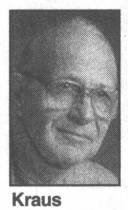 John Kraus, 94, physicist, astronomer, preservationist and benefactor, died of natural causes Sunday in his Liberty Township home.
John Kraus, 94, physicist, astronomer, preservationist and benefactor, died of natural causes Sunday in his Liberty Township home.
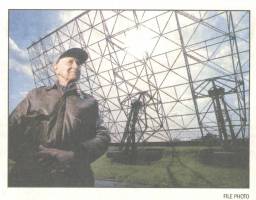
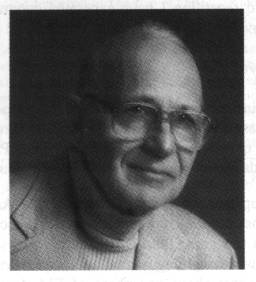
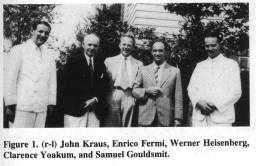
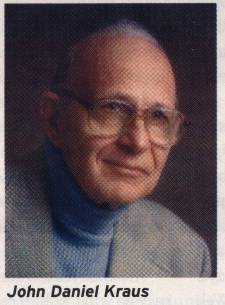 BY RONALD J. MARHEFKA
BY RONALD J. MARHEFKA
